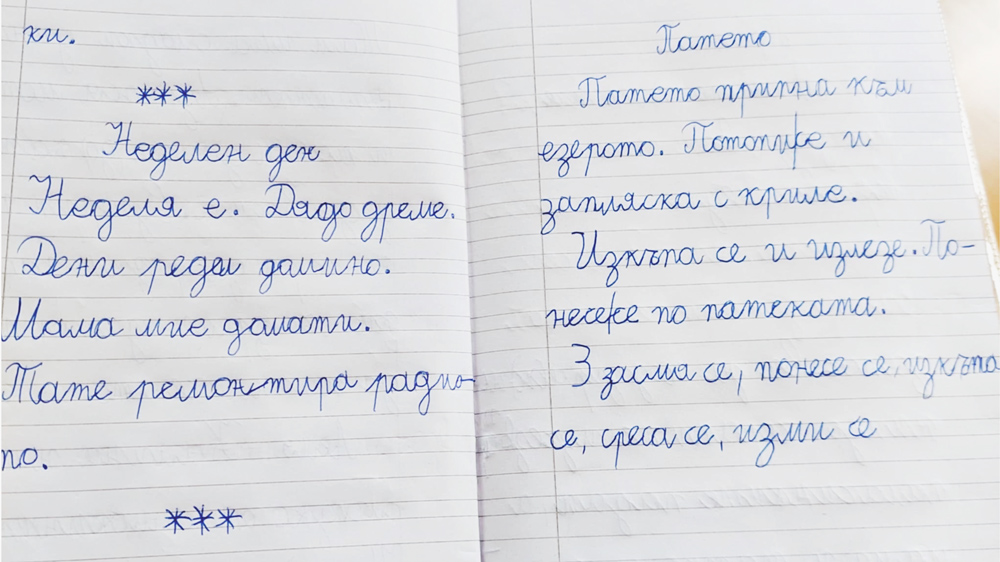In 1995, little Aleks went to school for the very first time.
I was 7 years old, wide-eyed and eager to learn. I always wanted to be at the top of the class, though I never quite was. My parents didn’t push for perfect grades, but I felt a quiet sense of pride in doing my best. And since my name was first on the attendance register each day, I thought that surely meant I had to be number one at everything else.
Handwriting as a Subject: Краснопис
In Year 1 in Bulgaria, we had something very special: краснопис (pronounced krasno-pees)—a dedicated handwriting subject. It was not a quick warm-up, not something squeezed into the corner of an English lesson, but a focused and respected area of learning in its own right.
We were graded on our handwriting, and expectations were high. Letters had to be beautiful, uniform, and legible. Presentation mattered, and our carefully written work was proudly displayed for everyone to see.
And I loved it.
The calm of sitting down to write, the rhythm of the pen, the focus and flow—it felt peaceful, creative, and joyful.
The 24th of May: A Celebration of Letters and Learning
Growing up in Bulgaria, the 24th of May held a special place in our hearts. It’s celebrated as the Day of the Bulgarian Alphabet, Culture, and Literacy, a public holiday dedicated to honouring the work of Saints Cyril and Methodius, the creators of the Glagolitic alphabet, the earliest known Slavic script.
This day isn’t just a celebration of language, it’s a celebration of identity, education, and the power of the written word.
As children, we would march in school parades, recite poems, and sing songs that praised the alphabet and its creators. We felt immense pride in our letters, our language, and our learning.
So much of that pride came from handwriting. From being able to shape our thoughts into something visible, something beautiful, and something uniquely ours.
A Surprising Realisation
Years later, when I moved to the UK and began teaching, I was surprised to discover that handwriting wasn’t given the same level of importance in many classrooms. Of course, with the rise of digital tools and technology, it’s easy to see how handwriting could be seen as less essential.
But I still believe handwriting matters. Deeply.
Why Handwriting Still Deserves a Place in Our Classrooms
Handwriting isn’t just about forming letters. It’s about:
- Cognitive development
- Fine motor skill building
- Visual-motor integration
- Memory and concentration
- Multitasking and brain development
In fact, studies have shown that the physical act of writing helps children process and retain information more effectively than typing. It’s also a powerful emotional regulation, confidence, and self-expression tool.
A Little Piece of the Past
I recently tried to dig out my old handwriting notebooks to show my students and followers, but sadly, they’ve been lost to time and many house moves. Thankfully, a kind friend came to the rescue and shared photos of her son’s handwriting from Bulgaria, a beautiful reminder that this art is still alive and well in some parts of the world.

Let’s Not Lose the Magic
Handwriting might seem “nice to have” in today’s fast-paced, tech-driven world. But I believe it’s so much more than that. It’s a life skill. It’s brain-building. It’s calming. It’s confidence-boosting. And most of all, it’s a way for children to connect with their own learning and creativity.
Let’s not forget that handwriting isn’t just about neat letters.
It’s a form of self-expression, a tool for learning, and a lifelong gift.
Looking for ways to support your child’s handwriting at home or in the classroom?
Explore our creative, joyful approach at Learn with Aleks and Scribble the Squirrel—where handwriting is made fun, rhythmic, and meaningful. ✍️
And to all who celebrate on the 24th of May—Happy Day of the Bulgarian Alphabet, Culture, and Literacy. Here’s to the power of letters and the beauty of handwriting.

0 Comments